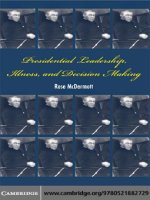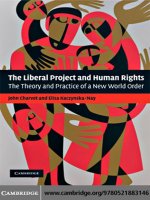0521853036 cambridge university press style language variation and identity aug 2007
Bạn đang xem bản rút gọn của tài liệu. Xem và tải ngay bản đầy đủ của tài liệu tại đây (1.79 MB, 224 trang )
Style: Language Variation and Identity
Style refers to ways of speaking – how speakers use the
resource of language variation to make meaning in social
encounters. This book develops a coherent theoretical
approach to style in sociolinguistics, illustrated with copious
examples. It explains how speakers project different social
identities and create different social relationships through
their style choices, and how speech-style and social context
inter-relate. Style therefore refers to the wide range of strategic actions and performances that speakers engage in, to construct themselves and their social lives. Coupland draws on
and integrates a wide variety of contemporary sociolinguistic
research as well as his own extensive research in this field.
The emphasis is on how social meanings are made locally, in
specific relationships, genres, groups and cultures, and on
studying language variation as part of the analysis of spoken
discourse.
C O U P L A N D is Professor and Research Director
of the Cardiff University Centre for Language and Communication Research. He is a founding co-editor of the Journal
of Sociolinguistics.
NIKOLAS
KEY TOPICS IN SOCIOLINGUISTICS
Series editor:
Rajend Mesthrie
This new series focuses on the main topics of study in sociolinguistics
today. It consists of accessible yet challenging accounts of the most
important issues to consider when examining the relationship between
language and society. Some topics have been the subject of sociolinguistic
study for many years, and are here re-examined in the light of new
developments in the field; other are issues of growing importance that
have not so far been given a sustained treatment. Written by leading
experts, the books in the series are designed to be used on courses and in
seminars, and include suggestions for further reading and a helpful
glossary.
Already published in the series:
Politeness by Richard J. Watts
Language Policy by Bernard Spolsky
Discourse by Jan Blommaert
Analyzing Sociolinguistic Variation by Sali A. Tagliamonte
Language and Ethnicity by Carmen Fought
Forthcoming titles:
World Englishes by Rakesh Bhatt and Rajend Mesthrie
Bilingual Talk by Peter Auer
Style
Language Variation and Identity
NIKOLAS COUPLAND
CAMBRIDGE UNIVERSITY PRESS
Cambridge, New York, Melbourne, Madrid, Cape Town, Singapore, São Paulo
Cambridge University Press
The Edinburgh Building, Cambridge CB2 8RU, UK
Published in the United States of America by Cambridge University Press, New York
www.cambridge.org
Information on this title: www.cambridge.org/9780521853033
© Nikolas Coupland 2007
This publication is in copyright. Subject to statutory exception and to the provision of
relevant collective licensing agreements, no reproduction of any part may take place
without the written permission of Cambridge University Press.
First published in print format 2007
eBook (NetLibrary)
ISBN-13 978-0-511-35005-4
ISBN-10 0-511-35005-8
eBook (NetLibrary)
ISBN-13
ISBN-10
hardback
978-0-521-85303-3
hardback
0-521-85303-6
Cambridge University Press has no responsibility for the persistence or accuracy of urls
for external or third-party internet websites referred to in this publication, and does not
guarantee that any content on such websites is, or will remain, accurate or appropriate.
Contents
List of figures and tables vii
Preface and acknowledgements ix
Transcription conventions xiii
1. Introduction 1
1.1 Locating ‘style’ 1
1.2 Variationism in sociolinguistics 4
1.3 Style in sociolinguistics and in stylistics 9
1.4 Social meaning 18
1.5 Methods and data for researching sociolinguistic
style 24
1.6 Style in late-modernity 29
1.7 Later chapters 31
2. Style and meaning in sociolinguistic structure 32
2.1 Stylistic stratification 32
2.2 Limits of the stratification model for style 37
2.3 ‘Standard’ and ‘non-standard’ 42
2.4 ‘Non-standard’ speech as ‘deviation’ 45
2.5 Social structure and social practice 47
3. Style for audiences 54
3.1 Talking heads versus social interaction 54
3.2 Audience design 58
3.3 Communication accommodation theory 62
3.4 Some studies of audience design and speech
accommodation 64
3.5 Limits of audience-focused perspectives 74
4. Sociolinguistic resources for styling 82
4.1 Speech repertoires 82
4.2 The ideological basis of variation 85
4.3 Habitus and semantic style 89
4.4 Language attitudes and meanings for variation
93
v
vi
Contents
4.5
4.6
Metalanguage, critical distance and performativity
Sociolinguistic resources? 103
5. Styling social identities 106
5.1 Social identity, culture and discourse 106
5.2 Acts of identity 108
5.3 Identity contextualisation processes 111
5.4 Framing social class in the travel agency 115
5.5 Styling place 121
5.6 Voicing ethnicities 126
5.7 Indexing gender and sexuality 132
5.8 Crossing 137
5.9 Omissions 145
6. High performance and identity stylisation 146
6.1 Theorising high performance 146
6.2 Stylisation 149
6.3 Decontextualisation 155
6.4 Voicing political antagonism – Nye 156
6.5 Drag and cross-dressing performances 163
6.6 Exposed dialects 171
7. Coda: Style and social reality 177
7.1 Change within change 177
7.2 The authentic speaker 180
7.3 The media(tisa)tion of style 184
References 189
Index 206
99
Figures and tables
Figures:
The International Phonetic Alphabet
Consonants (Pulmonic)
Vowels xiv
Figure 2.1: Class and style stratification for (th) 33
Figure 2.2: Class and style stratification for (r) 34
Figure 2.3: Distributions of variants of (e), (ay) and (wedge)
among jocks and burnouts, boys and girls 52
Figure 3.1: Percentage of intervocalic /t/ voicing by four
newsreaders on two New Zealand radio stations,
YA and ZB 59
Figure 3.2: Sue’s convergence on (intervocalic t) voicing to
five occupation classes of client; input level taken as
Sue’s speech to ‘her own class’ 73
Tables:
Table 3.1: Foxy Boston’s vernacular usage in Interviews III and IV 66
Table 3.2: Percentages of less ‘standard’ variants of five
sociolinguistic variables in four ‘contexts’ of
Sue’s travel agency talk 72
Table 4.1: Mean ratings (whole sample, 5,010 informants) of
34 accents of English according to social
attractiveness and prestige 98
Table 6.1: Phonetic variables generally distinguishing South
Wales Valleys English and Received Pronunciation 158
vii
Preface and acknowledgements
In the new world of sociolinguistics, the simple concept of ‘style’ has a
lot of work to do. The idea of ‘stylistic variation’ emerged from
William Labov’s seminal research on urban speech variation and
language change, and it existed there in order to make a few key
points only. As Labov showed, when we survey how speech varies,
we find variation ‘within the individual speaker’ across contexts of
talk, as well as between individuals and groups. Also, when individual
people shift their ways of speaking, survey designs suggested that they
do it, on the whole, in predictable ways that are amenable to social
explanation.
From this initially narrow perspective, crucial as it was in establishing a basic agenda, a sociolinguistics of style has steadily come to
prominence as a wide field of research, whether or not researchers
use the term ‘style’ to describe their enterprise. Style used to be a
marginal concern in variationist sociolinguistics. Nowadays it points
to many of the most challenging aspects of linguistic variation, in
questions like these: How does sociolinguistic variation interface
with other dimensions of meaning-making in discourse? What stylistic work does variation do for social actors, and how does it blend into
wider discursive and socio-cultural processes? Are there new values
for variation and for style in the late-modern world?
When we work through issues like these, some important boundaries shift. For one thing, the study of sociolinguistic variation becomes
very much wider. The canonical study of language variation and
change will always remain a pillar of sociolinguistics, but it need not
be an autonomous paradigm. One of my ambitions for the book is to
show what variation study is like when it ‘goes non-autonomous’. The
boundary between ‘dialect variation’ and the social construction of
meaning in discourse starts to collapse. Theories and sensitivities
from different parts of sociolinguistics start to coalesce – interactional
sociolinguistics, pragmatics, anthropological linguistics and even
ix
x
Preface
conversation analysis do not need to stand outside of variationism,
nor it outside them.
My own thinking on sociolinguistic style has spanned two-and-a-half
decades, although it remains to be seen whether this particular quantitative index (like some other quantitative measures that come up for
review in the book) makes a meaningful difference. I was enthused to
write this book mainly because of the acceleration of sociolinguistic
interest in things ‘stylistic’ and ‘contextual’ and ‘socially meaningful’ in
the last decade, prompted by some remarkable new waves of research. I
won’t attempt to list the relevant names and paradigms here – they fill
out the pages of the book. But I would like to make a few biographical
notes, by way of personal acknowledgement.
I had begun writing about style in the late 1970s, when the theme
emerged from my doctoral research on sociolinguistic variation in
Cardiff, the capital city of Wales. I was fortunate to start long-running
dialogues, soon after that, with Allan Bell and Howard Giles. In their
own research they developed new relational perspectives on spoken
language variation that opened up an entirely new theoretical chapter
for sociolinguistics. I continued to collaborate with Howard Giles over
many years on various themes that lay at the interface between sociolinguistics and social psychology. I have been fortunate to be able to
develop some of that work, more recently, in collaboration with Peter
Garrett and Angie Williams in Cardiff, and more recently still with
Hywel Bishop.
After some scratchy ink and pen exchanges about his evolving theory
of audience design in the very early 1980s, Allan Bell and I maintained
close links, latterly in co-editing the Journal of Sociolinguistics. That particular collaboration ensured we would have no time to write collaboratively about style, although we had firmly intended to do this. I have no
doubt that this book would have been much the better if Allan and I had
achieved our aim of writing a similar book together.
As the Centre for Language and Communication Research at Cardiff
University grew and diversified through the 1980s and 1990s, several
of my colleagues there were involved in developing new sociolinguistic fields, particularly critical and interactional approaches to language and society. The study of style needed the sorts of insight that
they were developing in their own and in our joint research. In particular there has been the formative effect of my many collaborations
with Adam Jaworski, for example on metalanguage, sociolinguistic
theory and discourse analysis. My other Cardiff colleagues, including
Theo van Leeuwen and Joanna Thornborrow, have again been important sources of inspiration. My research collaborations with Justine
Preface
xi
Coupland, for example on the theme of discourse and ideology, social
identities in later life and on relational talk, have been where I developed most of the ideas behind the present book, although her contributions to this book are far too pervasive to summarise.
Apart from those already mentioned, a long list of people have made
very valuable input into my thinking and writing about ‘style’, whether
they recall it or not. No doubt with unintended omissions, let me thank
Peter Auer, Mary Bucholtz, Janet Cotterill, Penelelope Eckert, Anthea
Fraser Gupta, Janet Holmes, Tore Kristiansen, Ben Rampton and John
Rickford. Thanks also to Rachel Muntz and Faith Mowbray for their
help in connection with the BBC Voices research that has a walk-on part
in Chapter 4. Reading groups convened by Julia Snell, Emma Moore and
Sally Johnson fed back some valuable criticisms on parts of the text. Ayo
Banji made extremely helpful input into compiling the Index. Allan
Bell, Adam Jaworski and Natalie Schilling-Estes, as well as Rajend
Mesthrie, read and commented on the whole manuscript in draft
form, for which I am extremely grateful.
I have summarised and rewritten parts of my previously published
writing in this book. The main sources in this connection, listed in the
References section, are Coupland 1980, 1984, 1985, 1988, 2000b,
2001b, 2001c, 2003, in pressa, in pressb, Coupland and Bishop 2007,
Coupland, Garrett and Williams 2005, Coupland and Jaworski 2004. I
am particularly grateful to my co-authors for letting me rework some
parts of this material here. Figures 2.1 and 2.2 are adapted from
Figures 7.23 and 7.11 in Labov (2006).
The disciplinary boundary-shifting that I referred to above has
presented me with the problem of knowing where to draw the line
around style in this book. I have given most space to those studies of
how classical forms of sociolinguistic variation – what most people
call accent and dialect features – are worked into discursive social
action and where they make meaning at the level of relationships and
personal or social identities. As I say later, this is a rather artificial
boundary to try to police, because my motivating concerns for the
book are social meaning and social identity, much more than sociolinguistic variation itself. For example, I would have liked to include
some detail on the discursive management of age-identities in later
life (an area of my own my research with Justine Coupland). But this
would have taken the book away from indexical meanings linked to
the domains of social class, gender and racial/ ethnic identities, which
is where style research has been most active to date.
This book can be read as a critique of variationist sociolinguistics.
Meaning-making through talk has not been what variationists have
xii
Preface
generally tried to explain, although it has seemed to me a strange
omission. It is all the more strange when we think of William Labov’s
commitment to the politics of language variation, his interest from the
outset in the social evaluation of varieties, and his ground-breaking
work in narrative analysis and interactional ritual. His followers in the
field of variationist sociolinguistics have not often been able to maintain that breadth. In order to bridge back into questions of social
meaning, I have found it important to challenge some of the assumptions of variationist research. These are mainly its dogged reliance on
static social categories, its imputation of identity-values to numerical
patterns (quantitative representations of linguistic variation), and its
thin account of social contextualisation.
I fully recognise that, and celebrate the fact that, variationist sociolinguistics has taken great strides through keeping within these constraints, when research questions have been formulated at the level of
linguistic systems and how they change. But I think we need a sociolinguistics of variation for people and for society, as well as (not instead
of) a sociolinguistics of variation for language. ‘Sociolinguistic style’ has
been the rubric under which quite a lot of that extension of the
programme has already been achieved, and where further progress
is clearly in prospect. ‘Stylistics’, as a label for a sub-discipline of
linguistics, has a dated feel to it, and so does ‘style’. But in the context
of sociolinguistics, style nevertheless points us to a range of highly
contemporary phenomena. We seem to find meaning in our lives
nowadays less through the social structures into which we have
been socialised, and more through how we deploy and make meaning
out of those inherited resources. How social reality is creatively styled
is a key sociolinguistic question, and the main question in what
follows.
NC
July 2006
Transcription conventions
Where necessary, International Phonetic Alphabet (IPA) symbols are
used to identify consonant and vowel qualities, as in the following
charts (as shown over).
THE INTERNATIONAL PHONETIC ALPHABET
EXTRACTS OF TRANSCRIBED CONVERSATION
These are numbered consecutively within each chapter. Where possible, I have re-transcribed data extracts from the original sources in the
interests of simplicity and consistency. Wherever possible, these transcriptions use orthographic conventions, but with the following additions and deviations:
(.)
(2.0)
[quietly]
[ ]
:
::
you
?
(( ))
italics
a short untimed pause of less than one second
a timed pause, timed in seconds
stage directions and comments on context or spoken
delivery
between lines of transcript, denotes overlapping
speech, showing beginning and end points of overlap
lengthened sound
more lengthened sound
(underlined) said with heavy stress
marks question intonation not interrogative syntax
inaudible speech sequence or unreliable transcription
sequences of particular analytic interest, explained in
the text
Any other conventions used in particular extracts are explained in
the text.
xiii
The International Phonetic Alphabet (revised to 1993, updated 1996)
1 Introduction
1.1 LOCATING ‘STYLE’
‘Style’ refers to a way of doing something. Think of architectural styles
and the striking rustic style of house-building in rural Sweden. That
particular style – what allows us to call it a style – is an assemblage of
design choices. It involves the use of timber frames, a distinctively
tiered roofline, a red cedar wood stain and so on. We can place this
style. It belongs somewhere, even if the style is lifted out of its home
territory and used somewhere else. It has a social meaning. The same
is true for styles in all other life-domains. Cultural resonances of time,
place and people attach to styles of dress and personal appearance
in general, to styles in the making of material goods, to styles of social
and institutional practice, perhaps even to styles of thinking. We
could use David Machin and Theo van Leeuwen’s (2005) idea of ‘social
style’ to cover all these. The world is full of social styles.
Part of our social competence is being able to understand these
indexical links – how a style marks out or indexes a social difference –
and to read their meanings. The irony is that, if we ourselves are
closely embedded in a particular social style, we may not recognise
that style’s distinctiveness. Reading the meaning of a style is inherently a contrastive exercise. You have to find those red cedar buildings
‘different’ in order to see them as having some stylistic significance.
This is the old principle of meaning depending on some sort of choice
being available. But style isn’t difference alone. When we use the term
‘style’ we are usually attending to some aesthetic dimension of difference. Styles involve a degree of crafting, and this is why the word
‘style’ leaks into expressions like ‘having style’, ‘being in style’ or
‘being stylish’. The aesthetic qualities of styles relate, as in the case
of the Swedish red cedar buildings, to a process of design, however
naturalised that process and its results might have become in our
experience. We talk about ‘style’ rather than ‘difference’ when we
1
2
STYLE
are aware of some holistic properties of a practice or its product. A
style will ‘hang together’ in some coherent manner. Engagement with
style and styles, both in production and reception, will usually imply a
certain interpretive depth and complexity. Although we are considering ‘style’ as a noun at this point, when we refer to ‘a style’ and to
‘styles’ (plural), and giving styles a quality of ‘thing-ness’, the idea of
style demands more of a process perspective. I think we are mainly
interested in styles (noun) for how they have come to be and for how
people ‘style’ (verb) meaning into the social world. ‘Styling’ – the
activation of stylistic meaning – therefore becomes an important
concept in this book.
This general account of style can of course be applied to linguistic
forms and processes too. We are all familiar with the idea of linguistic
style, and most people will think first of language in literary style.
Literary style relates to the crafting of linguistic text in literary genres
and to an aesthetic interpretation of text. This book is about style in
speech and about ways of speaking, not about literary style, although it
would be wrong to force these areas of study too far apart. The book is
about style in the specific research context of sociolinguistics, where
concepts very similar to ‘social style’ have been established for several
decades. The general sociolinguistic term used to refer to ways of
speaking that are indexically linked to social groups, times and places
is dialects. Dialects are social styles. Some dialects are in fact rather like
red cedar timber buildings, redolent with meaningful associations of
rurality and linked to particular geographical places. They have strong
cultural associations, especially when we look at them contrastively.
Dialectologists have traditionally looked for boundaries between dialect regions, and traced the evolution of dialects over time and the
consequences of dialects coming into contact with each other
(Chambers and Trudgill 1999).
We are likely to think of dialects in this sense as being the social
styles of yesteryear, largely out of step with the social circumstances of
contemporary life. But dialect differences are of course a characteristic of modern life too. Dialects are evolving social styles and they can
be read for their contemporary as well as their historical associations –
associations with particular places (geographical dialects) and with
particular social groups (social dialects). Dramas associated with dialect are played out as much in cities as in rural enclaves, and sociolinguistics for several decades has enthusiastically teased out the
complexities of language variation in urban settings. The human
and linguistic density of cities invites an analysis in terms of ‘structured difference’. Cities challenge the view that one discrete social
Introduction
3
style (e.g. a dialect) is associated with one place, which was the basic
assumption in the analysis of rural dialects. It has become the norm to
consider cities as sociolinguistic systems that organise linguistic variation in complex ways. But understanding the social structuring of
styles, even in the sophisticated manner of urban sociolinguistics, is
not enough in itself. We need to understand how people use or enact or
perform social styles for a range of symbolic purposes. Social styles
(including dialect styles) are a resource for people to make many
different sorts of personal and interpersonal meaning. As I suggested
might be generally true for intellectual interest in style, what matters
for linguistic style is more to do with process than with product, more
to do with use than with structure. Stylistic analysis is the analysis of
how style resources are put to work creatively. Analysing linguistic
style again needs to include an aesthetic dimension. It is to do with
designs in talk and the fashioning and understanding of social
meanings.
So this is not a book about dialectology either. My starting point is
certainly the sociolinguistics of dialect, as it has been carried forward
by variationist sociolinguistics in the tradition of William Labov’s
research. This is where the term ‘style’ was first used in sociolinguistics, and one of my aims for the book is to map out the main steps
that sociolinguists have taken using the concept of style. This will
initially be a critical review, focusing on the limited horizons of style
research in variationist sociolinguistics. The positive case to be made,
however, is that, under the general rubric of style, sociolinguistics can
and should move on from the documenting of social styles or dialects
themselves. It should incorporate the priorities I have just sketched –
analysing the creative, design-oriented processes through which
social styles are activated in talk and, in that process, remade or
reshaped. This means focusing on particular moments and contexts
of speaking where people use social styles as resources for meaningmaking. It means adding a more active and verbal dimension (‘styling
social meaning’) to sociolinguistic accounts of dialect (‘describing
social styles’).
To set the scene for later arguments and debates, several core concepts need to be explored in this introductory chapter. First we need to
consider variationist sociolinguistics and its general approach to style.
Then we will look back at the early history of stylistics (the general
field of research on style in linguistics), to appreciate the climate in
which sociolinguistics first came to the idea of style. The idea of social
meaning then comes up for initial scrutiny. Looking ahead to the
more contemporary research that this book mainly deals with, we
4
STYLE
will then consider research methods and the sorts of sociolinguistic
data that we can deal with under the heading of style research. The
wider relevance of style to contemporary social life, which can be
characterised by the term ‘late-modernity’, is then reviewed. Finally
in this chapter, I give a short preview of the structure of the rest of
the book.
1.2 VARIATIONISM IN SOCIOLINGUISTICS
Sociolinguistics is, as they say, a broad church. The blander definitions
of sociolinguistics refer to studying language ‘in society’ or language
‘in its social context’. Other definitions focus on studying linguistic
diversity or language variation. What these simple definitions have in
common is that they give priority to language, then add some summary idea of what aspect of language is to be given priority (its
variability) or what sort of data is to be given priority (social manifestations of language). Definitions like these have to be understood
historically. It was once important to stress ‘social contexts’ in defining sociolinguistic priorities in order to challenge types of linguistics
where actual occurrences of spoken language were not given priority.
Even though most people would agree that using language is an
inherently social process, sociolinguists needed to make a case for
observing language as it is used in everyday life and for not relying on
intuited or fabricated instances of language. Stressing variability has
been important in order to resist the ideological assumption that what
matters in language is linguistic uniformity and ‘standardness’.
William Labov used the notion of secular linguistics to describe his
approach to language variation and change. The idea was that studying variable language forms, ‘non-standard’ as well as ‘standard’
forms, challenges what we might think of as the high priesthood of
theoretical linguistics and its reliance on idealised linguistic data. It
also challenges the belief that ‘standard’ language is more orderly and
more worthwhile than ‘non-standard’ language.
But the study of language variation and change has been in the
mainstream of sociolinguistics for four decades. Variationist sociolinguistics, as the approach developed by Labov is generally called,
has developed its own powerful principles of theory and method
(Chambers 1995/2003; Labov 1966, 1972a, 1972b, 1994, 2001a;
Chambers, Trudgill and Schilling-Estes 2004). In this book I intend to
take the considerable achievements of variationist sociolinguistics for
granted, and to ask what it has not achieved, particularly in relation to
Introduction
5
the notion of style and the active dimension of styling. So, as I have
mentioned, my orientation is a critical one, although I intend it to be
constructively so. The negative part of my argument is that variationist sociolinguistics has worked with a limited idea of social context –
and styling is precisely the contextualisation of social styles. The survey
designs of variationist research, which have been remarkably successful in revealing broad patterns of linguistic diversity and change, have
not encouraged us to understand what people meaningfully achieve
through linguistic variation. Variationist sociolinguistics has produced impressive descriptions of social styles, but without affording
much priority to contextual styling.
What then are the general features of the variationist approach?
Sociolinguistic surveys of language variation give us detailed descriptions of how linguistic details of regional and social accents and
dialects are distributed. (‘Dialect’ is a general term for socially and
geographically linked speech variation, and ‘accent’ refers to pronunciation aspects of dialect.) Speakers are not fully consistent in how
they use accent or dialect features. Their speech will often, for example, show a mixture of ‘standard’ and ‘non-standard’ forms of the same
speech feature. Nor are individuals within any particular social category identical in their speech. So the sort of truth generated in variationist research is necessarily one based in generalisations and
statistical tendencies. These are ‘probabilistic’ truths, expressing
degrees of relative similarity and dissimilarity within and across
groups of speakers and social situations. The convention is to produce
averaged statistical values (e.g. percentages of people’s use of a particular linguistic feature in a particular social situation, or factor loadings in statistical tests) to represent patterns of linguistic variation. So,
accent variation between two different groups of speakers is usually
represented as the difference between one statistical value (perhaps a
percentage) and another.
Variationist research has very expertly shown that ‘speaking differently’ has to be defined in several stages. Stage one is typically to
identify a group of people who share a geographical characteristic,
such as living in the Midlands city of Birmingham in England, or for
that matter Birmingham in Alabama in the Southern USA. Within this
territory or ‘community’ of people who have lived in the city for all or
most of their lives, sub-groups are identified based on social criteria.
This sort of classification isolates, to take a random example, the
category of ‘young females in Birmingham with working-class jobs’,
distinguishing them from other social categories. In a second stage, the
research samples the speech of the different groups, usually through
6
STYLE
extended one-to-one sociolinguistic interviews. The researcher then
counts how often a particular speech feature is used.
For example, in the English Birmingham, the issue might be how
often each speaker pronounces the diphthong vowel in words like
right and time with a phonetically backed and rounded starting point.
In this example, the local Birmingham pronunciation [OI] is in opposition to [aI] which is the less localised and more ‘standard’ variant in
England. Phonetic forms occupying intermediate positions between
these variants might also be recognised. Variant forms of sociolinguistic variables tend to be influenced by the details of their linguistic
placement. For pronunciation variables (linked specifically to a speaker’s accent, then), the positions that different pronunciation forms
occupy in the stream of speech-sounds, and the sets of words that they
occur in, are factors that are likely to impact on the frequency with
which they are used. These patterns might affect everyone’s speech. A
typical finding would then be that most speakers in the sample would
in fact use a mixture of different pronunciation forms – e.g. using both
‘standard’ and ‘non-standard’ variants of this sociolinguistic variable
(ai). But overall frequencies of use would very probably differ across
speakers and sub-groups when statistical averages are taken.
At the end of the process of categorising and counting the distribution of various linguistic variants in a body of data, a type of statistical truth would emerge. It might allow us to say that, overall,
Birmingham speech does indeed have some distinctive tendencies of
pronunciation – different from the speech of other regions and from
‘standard English’ pronunciation. That is, descriptively speaking,
Birmingham speech is a relatively distinctive social style. The descriptive evidence would go some way towards distinguishing the city as a
‘speech community’, even though the ‘standard’, less-localised forms
of speech crop up in Birmingham too. But people living outside the
city would use some of the local or ‘non-standard’ feature less often
than those living in the city, or not at all. Looking at how speech is
socially organised within the city, we would probably be able to say
that the speech of particular social sub-groups in Birmingham differs
in some statistical respects. Perhaps, overall, women in Birmingham
use the [OI] feature in words like right and time less often than men do.
Perhaps women with more prestigious jobs use it less than women
with low-prestige jobs. So there are social styles, at least in a quantitative sense, associated with these groups too.
Labov, however, doesn’t use the term ‘style’ in this sense. He refers
to what I am calling ‘social styles’ of speech simply as ‘social variation’. He reserves the terms ‘style’ and ‘stylistic variation’ for a further
Introduction
7
sort of language variation that can be detected in sociolinguistic interviews (e.g. Labov 1972b). This is when he is able to show that, again in a
statistical sense, individual people speak ‘less carefully’ at some
points in an interview than they do at other points. When they are
being ‘less careful’ or more relaxed they will typically use features of
the local style more frequently than in their supposedly normal interview speech. In this way Labov introduced the idea of ‘stylistic variation’ to refer to ‘intra-individual’ speech variation – variation ‘within
the speech of single individuals’. This became a very familiar claim in
community-based studies of language variation and change, and we
will look at it in much more detail in Chapter 2. But it is important to
note that, although Labov is mainly concerned with social style at a
community level, his original insight about stylistic processes related
to the individual speaker and to particular social contexts of speaking.
That is, he was interested in what happens when an individual
speaker delivers a version of a social style in a range of particular
speaking situations. This proves to have been a seminal insight. As we
shall see, however, the survey methods that Labov pioneered tend not
to give priority to the local processes through which this happens.
They orient much more to styles than they do to styling. The convention of basing variationist research on speech in interviews clearly
limits the range of social contexts in which styling can be observed
and analysed.
Several other sociolinguistic traditions, beyond variationism, are
fully sensitive to contextualisation processes and have been so from
the earliest days of sociolinguistics. The ‘active contextualisation’
perspective on social style that I am arguing for in this book is already
established in other parts of sociolinguistics, and was central to Dell
Hymes, John Gumperz and others’ conception of the ethnography of
speaking (Hymes 1962, 1996; Bauman and Sherzer 1989; Gumperz
and Hymes 1972). The theoretical tension that we have to deal with
in later chapters is in fact well summed up by the contrasting implications of the terms ‘speech’ and ‘speaking’. The variationist study of
social styles/ dialects has oriented to speech and to speech data, when
it also needs to orient to speaking and to the styling of meaning in
social interaction. This is not an oversight or even a limitation of
variationist sociolinguistics in its own terms. Variationism has simply
set itself other primary objectives, linked to understanding language
systems and how they change, rather than understanding social
action and interaction through language. The objectifying priorities
of variationist sociolinguistics show through in much of its core terminology. The word ‘variation’ itself implies an analyst’s viewpoint,
8
STYLE
looking down at arrays of variant forms distributed over some spatial
matrix. What ‘varies’ is the community’s or the speaker’s language
system; more locally, what ‘vary’ are sociolinguistic variables (linguistic units of variable production) defined in the system. This organisation isn’t accessible to, or even directly relevant to, people engaged in
speaking and listening, although it is the variationist’s main concern.
What matters to people is the meaning that language variation might
add to their discursive practices – what people are trying to mean and
what they hear others to be meaning.
Formal category systems and taxonomies used by researchers in
many fields of inquiry often imply equivalence between categorised
units, along the lines of ‘this item is one of this type and goes here, and
that item is one of that type and goes there’. All research that is based
on coding and counting will make assumptions of this sort, and
variationist sociolinguistics does this too in some respects. Variant
forms of sociolinguistic variables are defined as being equivalent in
their referential meanings. In the (English) Birmingham example, the
phrase right time has the same linguistic (referential) meaning however it is pronounced, and [aI] and [OI] are, to that extent, equivalent in
their meaning. Whatever the speaker’s accent, the utterance seems to
convey the same basic information. But this approach reduces the
scope of the term ‘meaning’ and tends to wash out issues of value as
they attach to variable language in actual use. When said in a
Birmingham accent, the utterance and the speaker might conceivably
be held to be less convincing or authoritative, for example. The social
meaning of the utterance, depending on how it is phonologically
styled, might interconnect in significant ways with other social
aspects of the speech event in which it is embedded.
Bridging between survey orientations and practice orientations in
the sociolinguistics of variation seems an obvious development, even
though the objectives and assumptions of (broadly) Labovian and
(broadly) Hymesian sociolinguistics have traditionally been quite separate. But the separation of these two agendas is in many ways artificial.
There is a certain oddness in not addressing social interaction as a
medium for variation research, in addition to its commitment to
social surveying and to reaching generalisations at that level. There
is no inherent clash between ‘macro’ and ‘micro’ levels of variation
analysis. One important theme in later chapters is that local processes
of meaning-making depend on the affordances that socially structured variation in some sense provides, even though we need to be
far more precise than this about how levels of analysis inter-relate.
Speaking is the basic modality of language, where linguistic meaning
Introduction
9
potential is realised and where social meanings of different sorts are
creatively implemented. If we decide to engage with the idea of social
meaning, however we precisely define it, social meaning will not be
something separate from the activation and interpretation of meaning in acts of speaking. The term ‘discourse’ (despite the many different senses in which it can be used – see Jaworski and Coupland 2007) is
a useful shorthand for this wider concern. The research agenda
around style can therefore also be referred to as the analysis of ‘dialect
in discourse’.
Quantitative analysis of the distribution of speech variants among
groups of speakers is an abstraction away from the social process of
speaking and of making meaning in context. It is of course an entirely
legitimate research method, suited to its own purposes of generalising
about language variation and change. But investigating variation
in the context of social interaction is simply looking at language
variation in its primary ecosystem of discursive meaning, and it can
therefore claim to be a sociolinguistic priority. A more institutional
argument is that there should be benefits to any one tradition of
sociolinguistic research in reaching out to other traditions. So much
of sociolinguistics nowadays is grounded in analyses of discourse and
social interaction that, once again, it would be strange for variationism not to move into that arena. This move might allow us to find
other, more integrative, sorts of sociolinguistic truth.
1.3 STYLE IN SOCIOLINGUISTICS AND IN STYLISTICS
It should already be obvious that the term ‘style’ has significant but
largely different histories in sociolinguistics and in other fields. In the
sociolinguistics of variation, style has been a very limited concept and
a peripheral concern. In his overview of variationist sociolinguistic
research Jack Chambers writes that ‘style is an important independent
variable but it is never the focal point (Chambers 1995: 6). As we will
see in Chapter 2, stylistic variation has been treated quantitatively in
sociolinguistic surveys in exactly the same way as social (or social
class-related) variation is treated. It has been a matter of demonstrating that ‘intra-individual’ variation exists and that the nature of such
variation can be explained by some simple principle or other. In this
section, in order to gain some perspective, we return to some early
non-sociolinguistic treatments of language style. Naturally enough,
there are many points of contact and overlap between early sociolinguistic treatments of style and early stylistics. But those early
10
STYLE
emphases and interests have in fact persisted much longer in variationist sociolinguistics than they have in stylistics itself. Modern
stylistics has blended into different forms of discourse analysis, prefiguring some of the general arguments I am making in this book.
The discipline label ‘stylistics’ was popularised in the 1950s, and it
came to be thought of as a discrete field of linguistics or applied
linguistics. ‘General stylistics’ (Sebeok 1960) was interested in all
forms of language text, spoken and written, distinguished from the
sub-field of literary stylistics. Early stylistics was dominated by linguistic structuralism, which emphasised the structural properties of texts
at different levels of linguistic organisation (phonological, grammatical, lexical, prosodic). It gloried in the technical sophistication of
linguistic description, at a time when linguistics was still developing
momentum. Stylistics was largely based on taxonomies – lists of
language features, levels and functions. For example, a very simple
hierarchical analysis of English style was offered by Martin Joos in
his strangely titled book, The Five Clocks (1962). The ‘clocks’ were levels
of formality in spoken and written English, which Joos labelled ‘frozen’, ‘formal’, ‘consultative’, ‘casual’ and ‘intimate’. It was based on
an intuition about degrees of familiarity/intimacy between people
which, Joos argued, impacted on communicative style. The detail of
how Joos meant these terms to be applied is not particularly important here, but the ‘clocks’ idea endorses a linear scale of ‘formality’.
Formality or communicative ‘carefulness’ is assumed to dictate a
speaker’s stylistic choices or designs. As we’ll see, this is how Labov
came to operationalise sociolinguistic style too.
Roman Jakobson, in a famous lecture delivered in 1958 (Jakobson
1960, reprinted in Weber 1996a), is often credited with giving the first
coherent formulation of stylistics. Jakobson’s theme was the relationship between poetics (aesthetic response to language and text) and
linguistics. His argument was that the investigation of verbal art
or poetics is properly a sub-branch of linguistics. He reached this
position by establishing that the poetic function of language, which he
defined as ‘the set . . . towards the MESSAGE, focus on the message
itself’ (Jakobson 1996/1960: 15; reprinted in Weber 1996a: 10–35), is a
general function of all language use. It is not restricted to poetry and
other literary texts. Jakobson argued that, if language always has a
poetic function, linguistics must account for it, and that it could
and should therefore account for poetry and other artistic forms too.
The most original aspect of Jakobson’s paper is his attempt to list
all the main functions of language. The poetic function stands alongside the referential function (the cognitive ordering of propositional









